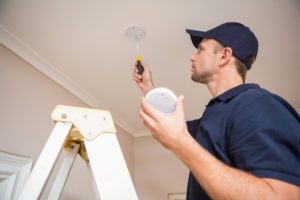 In 2015, the National Fire Protection Association released that every 86 seconds, a residential structure fire was reported. This equals to over 300,000 homes and about 7 billion dollars worth in damages. However, you can take steps towards fire prevention today. Check out our list of tips below:
In 2015, the National Fire Protection Association released that every 86 seconds, a residential structure fire was reported. This equals to over 300,000 homes and about 7 billion dollars worth in damages. However, you can take steps towards fire prevention today. Check out our list of tips below:
SMOKE ALARMS
Make sure there is at least one alarm installed on every floor of your home. These should be within hearing distance of any sleeping areas. If people sleep with their doors closed, install one in the room. Alarms should be connected so that if one goes off, they all go off, allowing people more time to escape. Check the batteries at least twice a year to confirm all alarms are in proper, working order.
FIRE SMART
Start teaching children from a young age that fire is not a toy. Keep items such as matches and lighters in a place where kids can’t reach them. If you smoke, never leave cigarettes or cigars unattended and ensure they are properly extinguished. Candles should only be used if they are properly attended and kept away from flammable objects such as curtains, plants, and furniture.
KNOW THE HAZARDS
House fires can be started by the most mundane items, so it’s important to be aware. A buildup of lint in your dryer can start a fire, so make sure you clear all lint after every load of clothing. All appliances and electrical items should be professionally installed and inspected. Fireplaces should be checked and cleaned at the beginning and end of winter.

KITCHEN SAFETY
Never leave anything cooking in the kitchen unattended, especially when working with grease or oil. Wear fitted clothing while cooking. A billowing sleeve or a hanging tie have the potential of becoming a hazard. If a grease fire on the stove starts, do NOT throw water on it. Either smother it with a metal lid or pot or pour baking soda on top of it.
CREATE ESCAPE PLAN
Even if you take all of the above precautions, you still need to be prepared for the worst. Sit down with your family and come up with a fire escape plan, including multiple ways to get out of the house, where to meet if you get separated, and how to reach 911 and other emergency contacts. This plan should be reviewed and practiced at least twice a year.



